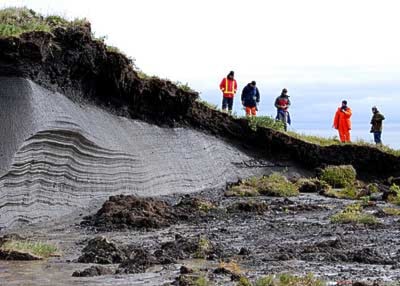Lemming love dens are hard to build.
This is not due to complexity. No candles, no mirrors, no Barry White music required, just lots of metal posts and more than a kilometre of orange, plastic snow fencing.
Chris Wilkinson and Colin Wright know all about it.
They’re both students in the renewable resource management program at Yukon College, and in August, their class visited the most remote corner of the Yukon: Herschel Island and nearby Komakuk Beach, 69° north, on the coast of the Beaufort Sea.
They spent much of their time lugging around fencing supplies and hammering posts into frozen dirt.
Welcome to the world of being a research assistant.
Herschel Island is only 116 square kilometres, but it supports all manner of Arctic wildlife. Caribou and muskox grazed not far from the students’ camp. Snowy owls and peregrine falcons swooped overhead. Red foxes, wolverines, and the occasional grizzly and polar bear also visit the island.
Many of these animals survive and thrive only because of the humble lemming.
These small rodents, which scurried and darted beneath Arctic willow shrubs as the students lugged their fencing supplies, are at the base of Herschel Island’s food web.
Lemming populations follow dramatic boom and busts, which usually peak every four years. And following the pulse of the lemming population are many other species, which rise and fall in number in rhythm with the rodents.
No one knows quite why lemming populations rise and fall as they do. But the newly-assembled snow fence may give researchers a better idea.
Lemmings largely live beneath the snow during the long Arctic winter. They dig burrows that are kilometres long, with their claws. The snow insulates the ground, providing slight warmth. And it provides lemmings cover from the many predators that feed upon them.
Some winters, lemmings mate. The fence, which ought to catch drifting snow, may help demonstrate how much lemmings depend upon deep snow for this to happen.
Lemmings, like other rodents, reproduce quickly. Just six weeks after birth, a lemming is ready to breed. A female may produce a litter of eight.
“So you can have great, great grandmothers breeding beside their descendents,” says Scott Gilbert, a renewable resources instructor at Yukon college, who has studied lemmings since 1990.
A lemming may live two years, but most will be lucky to survive a year before being gobbled up by a fox or owl.
“Most of them have short, brutish lives,” says Gilbert. “They just get cleaned up by these hungry predators.”
Predation, diminishing food supply, disease and lemming-on-lemming aggression may all be factors that contribute to the wild fluctuations of lemming populations. But one factor may be ruled out: the popular belief that they commit suicide by leaping off tall cliffs into the sea.
This notion was popularized by the 1958 Disney film White Wilderness. It’s false.
But the trip to Herschel, for Wright and Wilkinson, was about a lot more than lemmings.
The island has a rich history.
Thule, the predecessors of Inuvialuit, inhabited Herschel Island about 1,000 years ago. Inuvialuit continue to visit the island for hunting today.
In the 19th century, the island became a base for whalers who hunted and butchered enormous bowhead whales. It was once the home of about 1,500 whalers, making the island one of the biggest communities of the Yukon at the time.
It was the location of the first trial of the Arctic, and of the first hanging.
Among the island’s rich abundance of wildlife is the only nesting colony of black guillimots in Canada, Wright said.
But, above all, the trip was an eye-opening example of how climate change is altering the Arctic.
Herschel Island has no bedrock. It is, in the words of Gilbert, “consolidated marine muck that was pushed up by glaciers.”
In other words, it is a big pile of frozen dirt that is slowly sloughing off into the ocean.
The island’s erosion into the sea is, as far as examples of climate change go, “straight out of the textbook,” says Wilkinson.
It’s easy to become numbed and indifferent to news reports of climate change. But, Wilkinson says, “you go up there and you see it’s not a concept.
“It’s real, it’s happening.”
Fieldwork done by the students is part of the Arctic Wildlife Observatories Linking Vulnerable Systems project. The trip received funding from International Polar Year.
